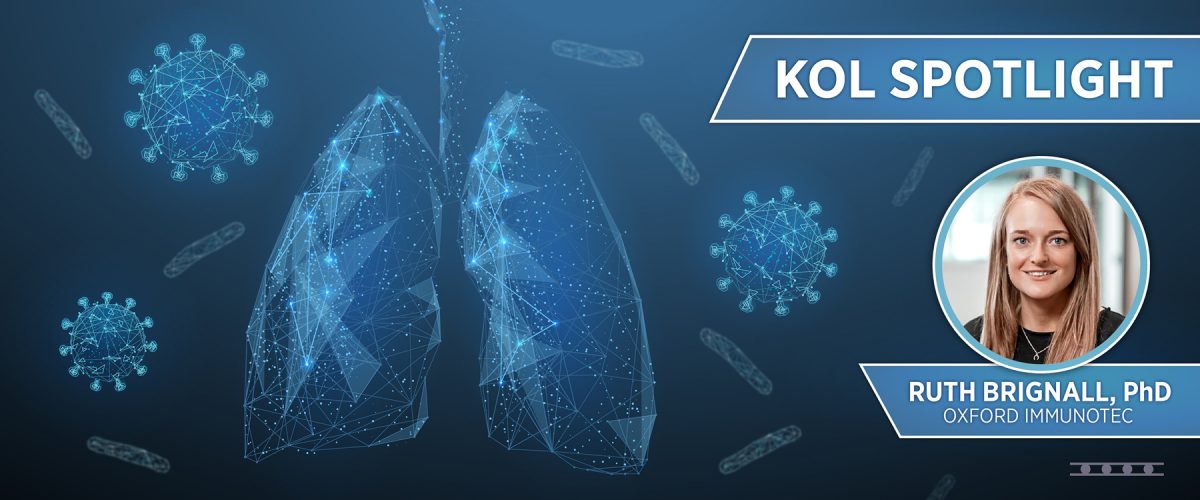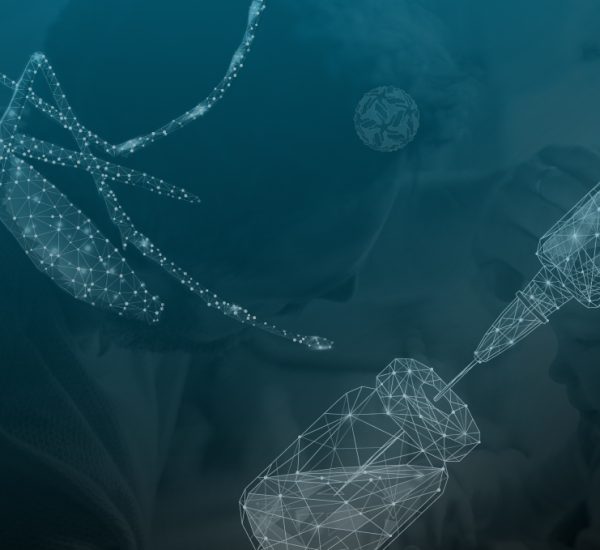KOL Spotlight Interviews is a segment where we interview experts in various fields on their expertise and insights that continue to help shape the diagnostics and pharmaceutical industries. This month, we have the pleasure of welcoming Dr. Ruth Brignall from Oxford Immunotec, a PerkinElmer company.

Dr. Ruth Brignall, PhD – Global Medical Expert at Oxford Immunotec
Dr. Ruth Brignall completed a PhD in immunology and a post-doc in cancer biology. She joined Oxford Immunotec, first as a Medical Science Liaison (MSL) and more recently as a Global Medical Expert. Below, we will learn more about her experiences and insights in tuberculosis and SARS-CoV-2 diagnostics.
Q: Ruth, what inspired your move from the bench to a science communication role? And can you tell us a little more about your main responsibilities as the Global Medical Expert?
A: I really enjoyed benchwork but the part of the job I really enjoyed while I was in research was presenting my data and talking about the science I was doing with other scientists. I loved networking, going to conferences, and sharing my findings with other people. That’s when I came across Medical Affairs. To me, the MSL role seemed perfect. It was all about communicating science with a whole range of different audiences while keeping really up to date with the most recent research and scientific findings.
In terms of the role now as Global Medical Expert, my main roles and responsibilities are around providing medical and scientific advice to the company on any Oxford Immunotec products. [Other responsibilities include] educating, influencing, and learning from key opinion leaders in the field about how Oxford Immunotec’s products can be used and made better, and what the important issues are in the diagnostics landscape.
Q: Oxford Immunotec was founded in 2002 and gradually made its way to being a leading diagnostics company, particularly in the detection of tuberculosis infection. Qiagen, another competitor, has been in the market for over 30 years. Can you tell us a little bit about the T-SPOT.TB® and what are some of the advantages of T-SPOT.TB® over traditional interferon-γ release assay (IGRA)?
A: There’s the T-SPOT®.TB test and other commercial IGRAs that work in quite different ways. The main difference is T-SPOT®.TB utilizes ELISPOT technology, whereas the other commercially available assays use ELISA methodologies. The differences start at sample preparation or pre-analytical stage. With the T-SPOT®.TB test, the sample prep involves taking a routine blood draw – a single vial of whole blood. From that whole blood, we isolate out the peripheral blood mononuclear cells (PBMCs) which are 70-85% T cells. These are the cells we want to look for to see if someone has generated an immune response to an infection. So, we isolate out this fraction of cells we are really interested in and then wash them to remove any interfering substances from it such as medications people are taking, any endogenous cytokines that are produced, or anything that could impact the results of the assay. Those are all removed from the cells before the assay is done. The final thing we do is count the cells before they are plated in the T-SPOT®.TB test. That allows us to normalize the number of cells going into each patient test, so that even if a patient has lower numbers of T cells than another patient, the exact same number of cells are going into the test to get a really reproducible result each time. Other commercial IGRAs do not do these washing and counting steps, and instead stimulate the cells whilst they are still in the whole blood.
Another major difference between T-SPOT®.TB and other commercial IGRA assays is the read-out of the test. In the T-SPOT®.TB test, the readout is spot-forming units on the bottom of the plate. Each individual spot represents an individual cell which is producing interferon-γ in response to the antigens we use in the test. So, you get this real single-cell resolution result. In other commercial IGRA assays, you get a population level readout which is the concentration of interferon-γ that’s been produced by an entire population of cells to get the result. What we really find is these advantages become helpful when we start thinking about immunosuppressed patients. When we think about the people who are at risk of progressing to active TB, that is generally those immunosuppressed people who are taking a medication, have a disease, or have social factors that really reduce their immune responses. What we find is this washing and counting of cells to standardize and normalize the number of cells, along with the individual cell readout means the test maintains its performance even the immunosuppressed population.
Q: As of 2020, there was an estimate of 13 million in the United States living with LTBI, per the CDC. And we suspect that number to be larger in other countries. From your experience, what are some challenges/bottlenecks seen with TB diagnosis worldwide?
A: You just identified the biggest challenge that we have, which is that most people who are infected with TB have a latent infection. That means they have no symptoms or signs of infection and are not sick. The good thing is that they can’t pass on the infection to other people at that stage. But they’re also not going to the doctors and getting tested because there’s nothing wrong with them. But in 5-10% of those people you have LTBI that progresses to active TB. That has symptoms like coughing up blood, weight loss, and fatigue that can be confused with many other things. Those people, who have developed active TB, can go out and spread it in the community and pass the infection onto others.
What’s being recognized worldwide now is that early detection and treatment of LTBI is critical to eradicating TB around the world. There are currently 2 types of tests available for LTBI. One is IGRAs like the T-SPOT®.TB test and the other is tuberculin skin test (TST). The TST is one of the oldest diagnostics. It’s been around for ages. One of the big advantages is it can be done from anywhere. All you need is someone to read the result on the person who’s been tested. You don’t need any lab processing, which is great. But there are a lot of limitations. If you’ve been BCG vaccinated or infected with a nontuberculous mycobacterium, it can cross-react with the TST leading to a false positive result. There’s also a lot of variability based on how each individual person reads the skin test. That’s why IGRA is being mentioned in guidelines worldwide as it can help to provide a more accurate diagnosis, especially in immunosuppressed populations and children that are at risk of progressing to active disease.
Q: With many bacterial or fungal infections, a growing concern is drug resistance which takes a toll on a patient from an adherence standpoint but also an economic standpoint. How does the growing drug resistance impact tuberculosis diagnoses and diagnostic testing?
A: TB is treated with a very long course of antibiotics for most people. It becomes harder and harder for people to adhere to the treatment regimens. That leads to misuse and mismanagement of the drugs that are available with can in turn lead to drug resistance, which we see in TB. One thing that’s been hugely advantageous in this space is video observed therapy. In the past, patients on TB medications would have to go into clinic and be observed taking that therapy. This was hugely disruptive to your day-to-day life to go to clinic. Now you can take a video on your phone or any device and send it to your doctor, and they can check to make sure you are adhering to the regimen you’re on. There is also progress towards shorter treatment regimens. This will be hugely helpful. People don’t have 9 months of treatment; it can be condensed now. There are new treatments coming out or being repurposed for TB that there isn’t much drug resistance against. Although it is a challenge, I think the community of doctors, healthcare providers and researchers are really changing the situation.
Q: As we know, T cells play a crucial role in adaptive immune response. Since the ELISPOT test is able to activate both CD4 and CD8 T-cell responses, is there a benefit (either for diagnosis or treatment purposes) to distinguish between CD4 and CD8 responses?
A: That’s a great and interesting question. There’s been several publications in the literature showing that CD8 T-cells are more heavily associated with a recent infection. And people who have been recently infected with TB are more likely to progress to active disease than people who’ve been infected for 10 years. There’s also a link between CD8 T-cells and those who have active disease. So, these publications were suggesting that maybe if you can pick up CD8 T-cells and if there’s a lot of them, that might be indicative of someone who is more likely progress or has already progressed to active TB.
Interestingly, QIAGEN released QFT-PLUS test which is the most recent iteration of the QFT test. In that test, they were able to distinguish between CD8 and CD4 T-cell responses by using 2 tubes instead of 1. Everyone thought this was going to be a great way to see if people have recently acquired the infection or were close to progressing to active TB. But so far, there hasn’t been a lot of evidence in the literature that suggests that you can pick up that CD8 T-cell response in a significant way or that it means that it is associated with a higher risk of progression to active disease. I think a lot more work needs to be done in that area. It’s an interesting area of research but there’s not enough evidence either way to know for sure.
Q: Let’s switch gears for a second to discuss the COVID-19 pandemic which has really impacted the lives of everyone around the world. The newly released T-SPOT® Discovery SARS-CoV-2 assay builds on Oxford Immunotec’s experience with diagnosis of tuberculosis using T-SPOT technology. What was the motivation behind adapting this technology for monitoring the immune response to SARS-CoV-2?
A: What Oxford Immunotec saw at the start of the pandemic was a laser focus on antibody testing. Antibody testing has undoubtedly played a huge role in the SARS-CoV-2 pandemic. But there are different aspects of the immune response. While antibodies look at the humoral branch of the immune response, T-cells are looking at the cell-mediated immune response.
Oxford Immunotec released a research-use only (RUO) kit which was the T-SPOT® Discovery SARS-CoV-2 test. This was to look at T-cell responses to structural proteins of the SARS-CoV-2 virus and understand if people were developing a cell-mediated immune response, in addition to the antibody response, which was already being well-tested. That was the motivation behind it. To truly understand what’s happening, you want to look at cell-mediated immunity and humoral immunity and get the full picture.
Q: With the increased spread of COVID-19 over the past year/year and a half, a lot of R&D priorities changed to aid in developing accurate tests and vaccines to prevent the spread of COVID-19. How have tuberculosis patients (specifically LTBI) been impacted by the COVID-19 pandemic? What geographic populations are more affected than others?
A: What happened in TB was that all routine testing was put on hold. If you’re talking about detecting TB infection early and treating it before it gets to active TB disease, that routine testing is absolutely critical to that. We saw a huge drop in TB testing worldwide for LTBI. Respiratory doctors who used to work on TB were pulled onto COVID. Whole TB wards have actually been converted into COVID-19 wards just to deal with the sheer volume of patients coming in at the height of the pandemic. Another aspect is that a lot of TB research stopped, and respiratory researchers moved on to COVID-19 and SARS-CoV-2 infection.
All of that meant the TB care was drastically reduced, especially during the peak, and we are just starting to see it coming back now. The ability to meet the goals set by the World Health Organization as part of the End TB Strategy will be more difficult to meet after losing focus on TB.
Q: In the United States and other countries around the world, more vaccines are being authorized for the prevention of COVID-19 virus. Many people are now interested in seeing how effective the vaccine is by measuring their antibodies levels. Despite that, are there any advantages to measuring the T-cell response to SARS-CoV-2 infection compared to measuring the antibody response? Can you explain why scientists might find it interesting to understand the T-cell response to SARS-CoV-2 infection?
A: As with everything when it comes to SARS-CoV-2, we can’t be 100% sure if there are advantages to measuring T cells over antibodies because nothing seems certain in this space. When the virus infects the body, we see an innate immune response which happens in a couple of days. Then those innate cells alert other cells of the immune system that the body is under attack. The cells they alert first are the T cells, which expand into this army of protective T cells against the virus or pathogen. These T cells orchestrate the immune response and help B cells start producing specific antibodies.
One advantage we see in potentially measuring T cells is that in the disease-pathology time course, you might see T cells being produced before you see specific antibodies being produced. There’s also been some evidence with SARS-CoV-2 infection that whilst antibody responses might wane over time, the T-cell response might be more robust. There’s also the studies which suggested that people who were infected with SARS-CoV-1, another human coronavirus, still have T cells today – 17 years later, that are specific to that SARS-CoV-1 virus.
This is really giving people a lot of hope and is encouraging that even if the antibody response might be waning, we might have that robust and long-lasting T-cell response that may still offer some protection even years after infection. But we don’t know yet whether T cells or antibodies or any of these immune response factors provide protection over SARS-CoV-2 and it’ll take longer to get that information.
Q: Along that same train of thought, we are getting closer and closer to seeing the light at the end of the tunnel, but considering the emergence of new SARS-CoV-2 variants, what do you see as possible hurdles that laboratories face in the detection of such cell-mediated immune responses?
A: There are a lot of challenges with this and there are concerns that diagnostic tests might not work [on the new variants] as well if they were designed against the original SARS-CoV-2 virus. When we look at T cell testing, and specifically thinking about the T-SPOT® Discovery SARS-CoV-2 test, the design of the test may offer some level of protection against these variants. We use overlapping peptides that span the length of some of the structural proteins of the SARS-CoV-2 virus. What that means is if you get a point mutation at one genomic region of the virus, you still have lots of other peptides in your peptide pool from the regions that haven’t been affected by that mutation that will still be initiating T cell responses.
We know that a lot of the mutations are happening in the spike protein of the SARS-CoV-2 virus or receptor-binding domain that helps the virus bind to host cells and get inside them and start replicating. If the test looks at other proteins, for example, the membrane or nucleocapsid protein, in addition to the spike protein, these regions are a little more conserved and stable. Tests may be able to avoid being impacted by the variants if they look at different structural proteins, as well.
Q: TST is one method of determining whether a person is infected with tuberculosis that we see quite often. And we know that live virus vaccines may affect results from that test. What impact, if any, do you suspect the mRNA COVID-19 vaccines (Pfizer & Moderna) to have on IGRA tests?
A: The vaccines have been designed to mimic what would happen if you were infected with the virus. Generally, if you are testing for a T-cell response to SARS-CoV-2 infection, you’re also going to be able to pick up a vaccine-induced response, as well. This is really great in the environment we’re currently in where everyone is being vaccinated but we haven’t yet seen how long-lasting the protection that’s provided by those vaccines is. Everyone can see the vaccine rollout is going well and it seems to be effective and dropping the numbers of people ending up in the hospital with severe COVID-19 disease. We don’t know how long that protection will last – is it going to be a year, will you need a booster? We don’t know. If you can detect the T cell response to vaccines, maybe that can give us some information on how long-lasting that immune protection might be, which will be a really positive use of tests like this when we try to get back to some level of normalcy.
Q: Ruth, this has been an insightful conversation and it is exciting to see how far the diagnostics world has come and how much further we have to go. With that said, it is no secret that Oxford Immunotec strives to transform science into meaningful insights, as we’ve seen with TB and SARS-CoV-2. Could the T-SPOT technology be used to measure T-cell responses in any other diseases besides TB and SARS-CoV-2?
A: The way the T-SPOT platform works and why we were able to mobilize so quickly and develop the RUO test when the pandemic started is that you can use the same platform but change the antigens you challenge the cells with. That can work with a whole host of different pathogens and diseases. T-cell diagnostics are moving in an interesting direction.
Personally, one big hope I have is that if we are thinking about pandemic preparedness – I don’t want to think of this happening again, but if it does – I hope when we are talking about antibodies straight away, we are talking about T cells, as well. Now we know we have platforms that can be mobilized quickly to give us the information on cell-mediated immune response just as fast as the antibody response.
Thank you Dr. Brignall for helping our audience from clinicians to laboratorians to patients gain a better understanding and perspective on tuberculosis and SARS-CoV-2 and the impact Oxford Immunotec continues to have.





